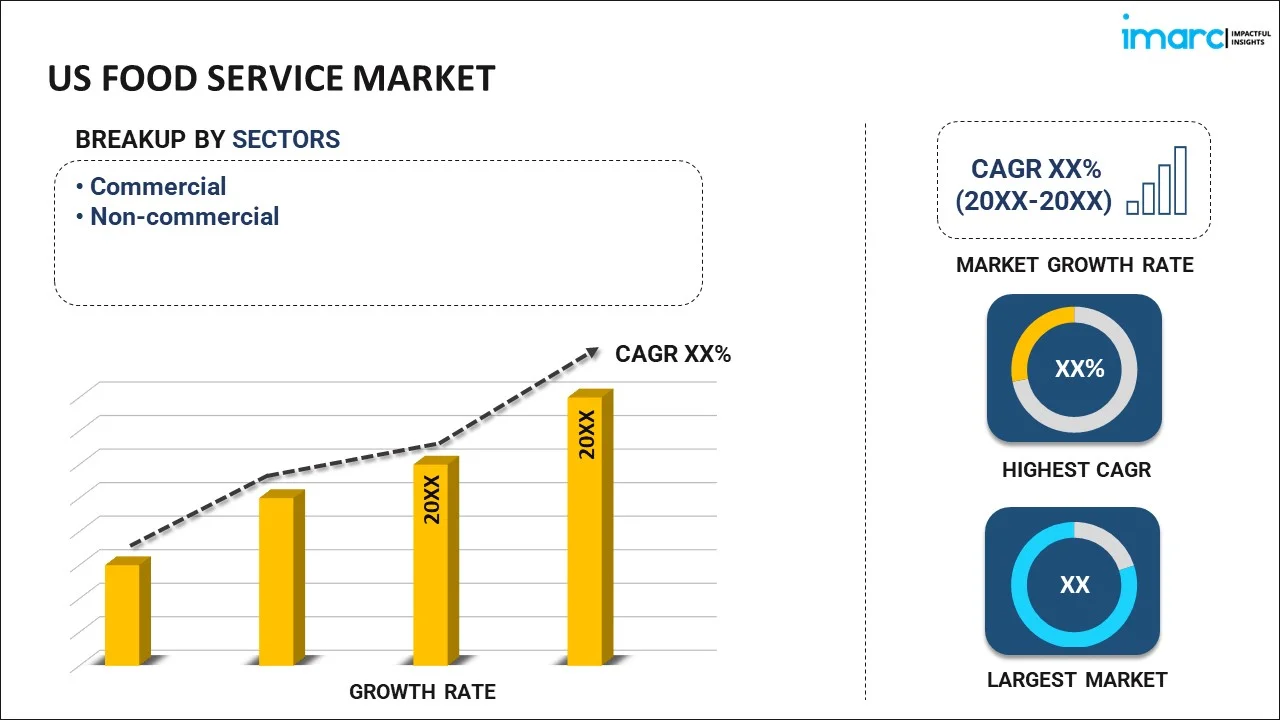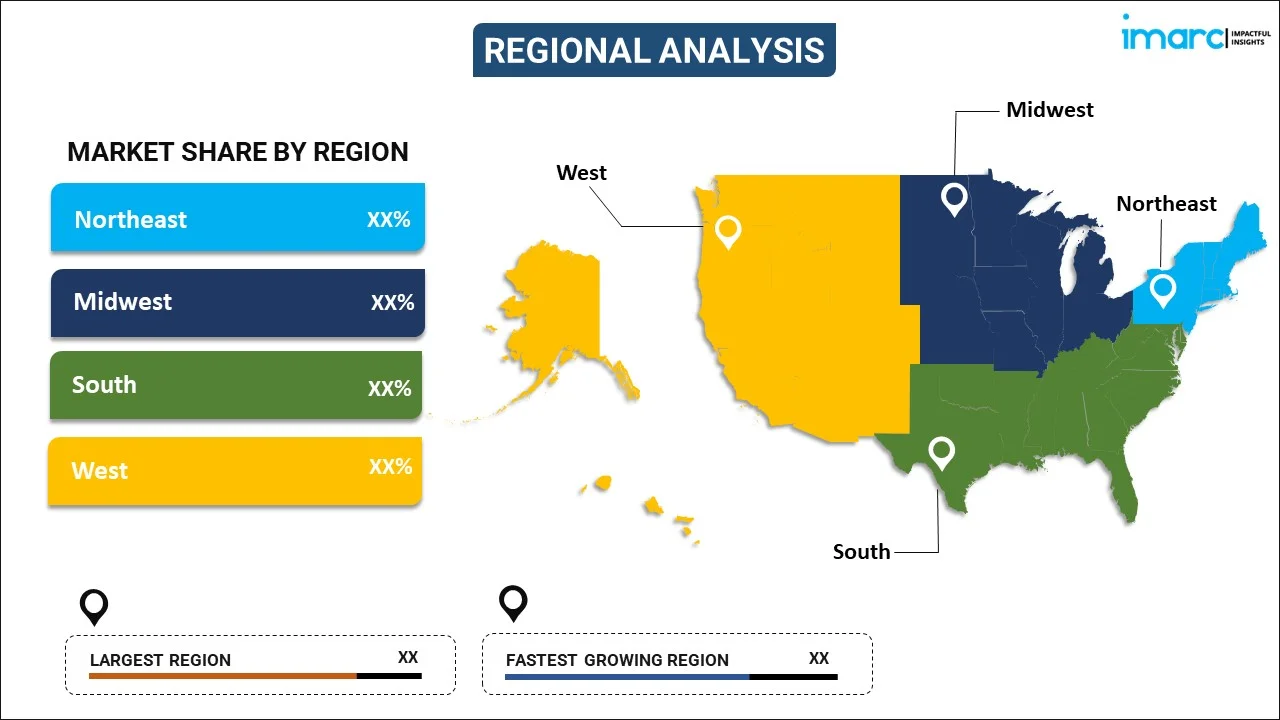
US Food Service Market Report by Sector (Commercial, Non-commercial), System (Conventional Foodservice System, Centralized Foodservice System, Ready Prepared Foodservice System, Assembly-Serve Foodservice System), Type of Restaurant (Fast Food Restaurants, Full-Service Restaurants, Limited Service Restaurants, Special Food Services Restaurants), and Region 2024-2032
Market Overview:
US food service market size reached US$ 1,423 Billion in 2023. Looking forward, IMARC Group expects the market to reach US$ 2,508 Billion by 2032, exhibiting a growth rate (CAGR) of 6.50% during 2024-2032. The increasing demand for automation in the kitchen, digital menus, and other innovations that can enhance efficiency and customer experience, is driving the market.
|
Report Attribute
|
Key Statistics
|
|---|---|
|
Base Year
|
2023
|
|
Forecast Years
|
2024-2032
|
|
Historical Years
|
2018-2023
|
|
Market Size in 2023
|
US$ 1,423 Billion |
|
Market Forecast in 2032
|
US$ 2,508 Billion |
| Market Growth Rate 2024-2032 | 6.50% |
Food service refers to the process of preparing, presenting, and delivering food to consumers. It encompasses a wide range of activities within the food industry, including restaurants, cafes, catering services, and institutional food providers. The primary goal of food service is to offer convenient and satisfying meals to customers, whether in a dining establishment, through take-out or delivery, or in large-scale settings such as schools or hospitals. Successful food service operations involve careful planning, efficient kitchen management, and a focus on delivering high-quality, safe, and flavorful dishes. Customer satisfaction is a key factor, and excellent service, appealing presentation, and adherence to hygiene standards contribute to a positive dining experience. The food service industry plays a vital role in meeting the diverse culinary preferences and nutritional needs of the public, reflecting cultural trends, and contributing to the overall hospitality and enjoyment of individuals and communities.
US Food Service Market Trends:
The food service market in the US is experiencing robust growth, driven by a multitude of factors. Firstly, the increasing regional population and urbanization have led to a surge in demand for convenient and ready-to-eat meals. Additionally, changing lifestyles and a rising preference for dining out have propelled the expansion of the food service sector. Moreover, advancements in technology have revolutionized the industry, with the widespread adoption of online food delivery platforms contributing significantly to market growth. Furthermore, evolving consumer preferences towards healthier food options and dietary trends, such as plant-based and organic offerings, are reshaping the landscape of the food service market. Notably, a growing awareness of sustainability and ethical practices in food production has influenced consumer choices, fostering the rise of eco-friendly and socially responsible establishments. In conclusion, a confluence of demographic shifts, technological advancements, and health-conscious consumer trends, collectively serve as the driving forces behind the thriving food service market. As these trends continue to shape consumer behavior, the industry is poised for sustained growth and adaptation in the years to come.
US Food Service Market Segmentation:
IMARC Group provides an analysis of the key trends in each segment of the market, along with forecasts at the country level for 2024-2032. Our report has categorized the market based on sector, system, and type of restaurant.
Sector Insights:

- Commercial
- Non-commercial
The report has provided a detailed breakup and analysis of the market based on the sector. This includes commercial and non-commercial.
System Insights:
- Conventional Foodservice System
- Centralized Foodservice System
- Ready Prepared Foodservice System
- Assembly-Serve Foodservice System
A detailed breakup and analysis of the market based on the system have also been provided in the report. This includes conventional foodservice system, centralized foodservice system, ready prepared foodservice system, and assembly-serve foodservice system.
Type of Restaurant Insights:
- Fast Food Restaurants
- Full-Service Restaurants
- Limited Service Restaurants
- Special Food Services Restaurants
The report has provided a detailed breakup and analysis of the market based on the type of restaurant. This includes fast food restaurants, full-service restaurants, limited service restaurants, and special food services restaurants.
Regional Insights:

- Northeast
- Midwest
- South
- West
The report has also provided a comprehensive analysis of all the major regional markets, which include Northeast, Midwest, South, and West.
Competitive Landscape:
The market research report has also provided a comprehensive analysis of the competitive landscape in the market. Competitive analysis such as market structure, key player positioning, top winning strategies, competitive dashboard, and company evaluation quadrant has been covered in the report. Also, detailed profiles of all major companies have been provided.
US Food Service Market Report Coverage:
| Report Features | Details |
|---|---|
| Base Year of the Analysis | 2023 |
| Historical Period | 2018-2023 |
| Forecast Period | 2024-2032 |
| Units | US$ Billion |
| Scope of the Report | Exploration of Historical Trends and Market Outlook, Industry Catalysts and Challenges, Segment-Wise Historical and Future Market Assessment:
|
| Sectors Covered | Commercial, Non-commercial |
| Systems Covered | Conventional Foodservice System, Centralized Foodservice System, Ready Prepared Foodservice System, Assembly-Serve Foodservice System |
| Types of Restaurant Covered | Fast Food Restaurants, Full-Service Restaurants, Limited Service Restaurants, Special Food Services Restaurants |
| Regions Covered | Northeast, Midwest, South, West |
| Customization Scope | 10% Free Customization |
| Report Price and Purchase Option | Single User License: US$ 3699 Five User License: US$ 4699 Corporate License: US$ 5699 |
| Post-Sale Analyst Support | 10-12 Weeks |
| Delivery Format | PDF and Excel through Email (We can also provide the editable version of the report in PPT/Word format on special request) |
Key Questions Answered in This Report:
- How has the US food service market performed so far and how will it perform in the coming years?
- What has been the impact of COVID-19 on the US food service market?
- What is the breakup of the US food service market on the basis of sector?
- What is the breakup of the US food service market on the basis of system?
- What is the breakup of the US food service market on the basis of type of restaurant?
- What are the various stages in the value chain of the US food service market?
- What are the key driving factors and challenges in the US food service?
- What is the structure of the US food service market and who are the key players?
- What is the degree of competition in the US food service market?
Key Benefits for Stakeholders:
- IMARC’s industry report offers a comprehensive quantitative analysis of various market segments, historical and current market trends, market forecasts, and dynamics of the US food service market from 2018-2032.
- The research report provides the latest information on the market drivers, challenges, and opportunities in the US food service market.
- Porter's five forces analysis assist stakeholders in assessing the impact of new entrants, competitive rivalry, supplier power, buyer power, and the threat of substitution. It helps stakeholders to analyze the level of competition within the US food service industry and its attractiveness.
- Competitive landscape allows stakeholders to understand their competitive environment and provides an insight into the current positions of key players in the market.
Need more help?
- Speak to our experienced analysts for insights on the current market scenarios.
- Include additional segments and countries to customize the report as per your requirement.
- Gain an unparalleled competitive advantage in your domain by understanding how to utilize the report and positively impacting your operations and revenue.
- For further assistance, please connect with our analysts.
 Inquire Before Buying
Inquire Before Buying
 Speak to an Analyst
Speak to an Analyst
 Request Brochure
Request Brochure
 Request Customization
Request Customization




.webp)




.webp)












